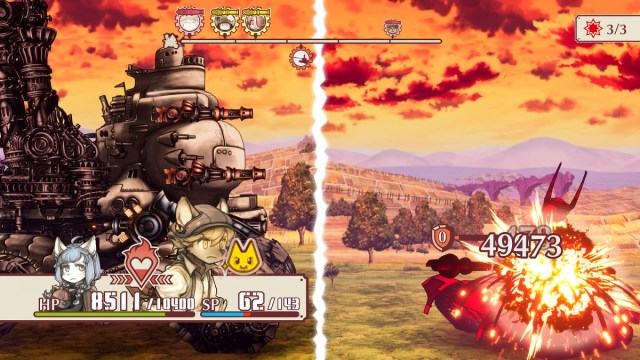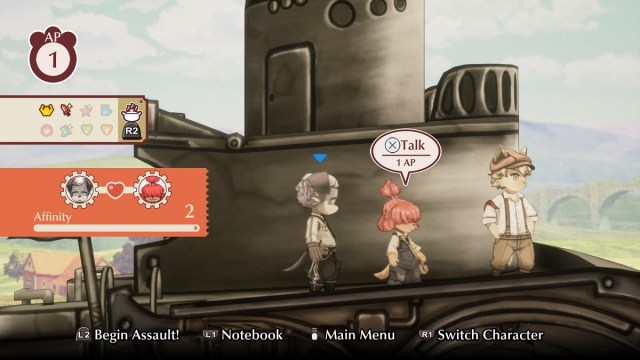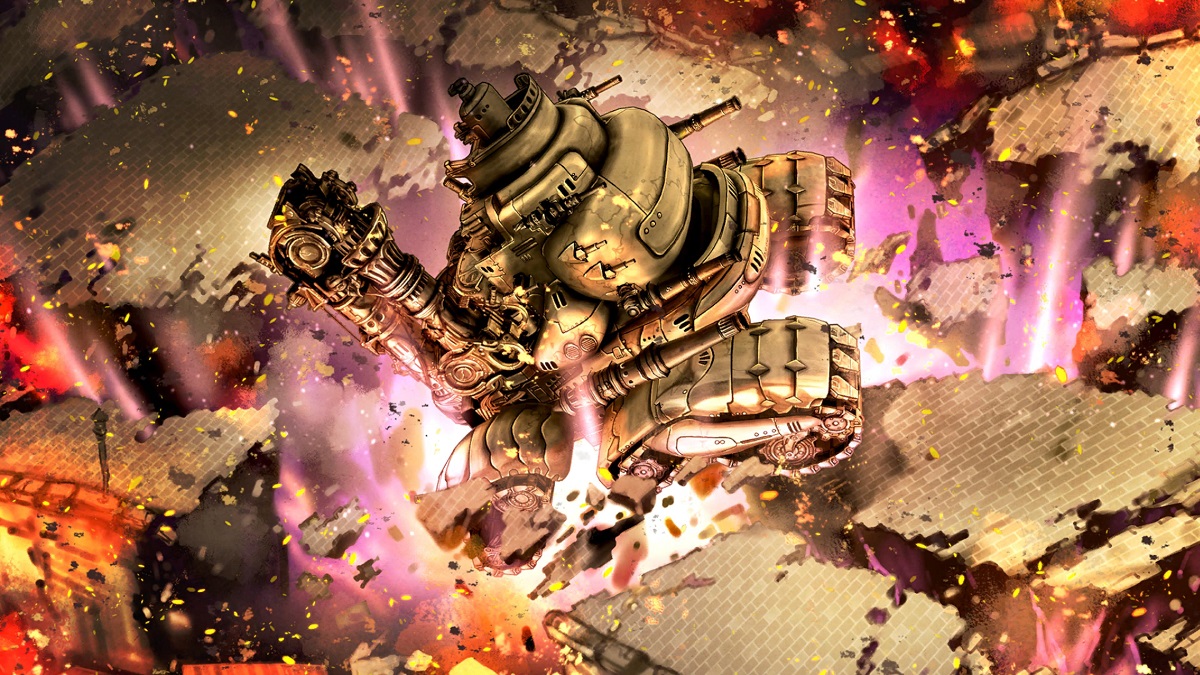In my armor-plated womb
The Phantom Limb from Venture Bros. explained to someone that “The Mona Lisa isn’t a better painting, merely a more famous painting.” It’s a quote that is an effectively concise way of explaining that something being mainstream is not necessarily an indicator of its quality. In the realm of video games, it is particularly useful, as the hyper-commercialized nature of it ensures that the cream doesn’t always rise to the top. Year after year, my favorite games are rarely the ones that are considered the period’s “big releases,” and that isn’t because I’m a snob. Sorry, I mean, that isn’t solely because I’m a snob.
2021’s Fuga: Melodies of Steel is an example of that. I personally overlooked the game for a couple of reasons. The first is that it didn’t get a whole lot of press, and the second is that, at $39.99, it has a high price tag compared to the games it appears to be competing against. Largely, the latter reason is a combination of me not having any money and small-budget games having been undervalued by a race to the bottom in mobile, PC, and XBLIG markets.
If my meandering around the point hasn’t made it clear, I think that’s a shame. Fuga: Melodies of Steel is a wonderful RPG experiment that shouldn’t be missed.

Fuga: Melodies of Steel (PC, PS4, PS5 [Reviewed], Xbox One, Xbox Series X|S, Switch)
Developer: CyberConnect2
Publisher: CyberConnect2
Released: July 28, 2021
MSRP: $39.99
Fuga: Melodies of Steel takes place in the Little Tail Bronx (Tail Concerto, Solatorobo: Red the Hunter) universe’s world of floating continents and furries. Unconnected to the previous games in the setting, Fuga: Melodies of Steel is a thinly veiled parallel to World War 2. The country of Gasco is suddenly invaded by the Berman Empire (I’m serious), who go to work rounding people up for unknown reasons. A group of children, narrowly escaping capture, find a massive abandoned tank – the Taranis – in a cave and set out with it to save their families.
Between this and Blaster Master on NES, video games really make it seem easy to just come across buried tanks. I feel like this is a widespread childhood experience that I’m angry I missed out on.
It may sound somewhat trite, but the mix of storybook whimsy and harsh reality is one of the things that makes Fuga: Melodies of Steel so interesting. Early on, you’re presented with a mechanic that allows you to load one of the children into a cannon that allows you to instantly kill any enemy at the expense of the child. Literally, and according to lore, someone developed a giant cannon that specifically uses children as ammunition. Finally, a way to make children useful.
I can make it sound as amusing as I want, but the soul cannon, as a concept, is dark as heck. Forget a good/bad morality system, Fuga: Melodies of Steel just allows you to sacrifice a character to prevent losing progress. It’s made somewhat obvious that by using the cannon, you’re setting yourself up for a less desirable ending, but there’s always new game plus.
Rhythms of Iron
Despite setting itself up as a narrative-focused game, Fuga: Melodies of Steel isn’t super heavy with exposition. There are plenty of cutscene interruptions, but most of them are quite brief. It makes the smart choice of spreading the tale out across the entire experience so it doesn’t get too bogged down.
The gameplay itself is quite unique. You build up a cast of 12 children, field 6 of them at a time, but only three are active in battle at a time. The other three you have in the immediate wings are there as emotional support, building up a gauge based on their relationship with the current gunner ahead of them, allowing you to unleash powerful attacks based on your combination once the gauge is full.
Each child commandeers one of three types of weapon: machine gun, grenade launcher, and cannon. While these are largely stacked in the order you’d expect – machine gun is light and accurate, cannon hits hard but is less reliable, and grenade launch is an all-arounder – that’s only part of the story. Enemies all have icons on them that denote a specific weakness, but they don’t take more damage from the indicated weapon. Instead, if they have three blue icons on them, for example, hitting them three times with a machine gun delays their next attack.
It’s a lot to get into, with the children’s skills, additional ammunition types, statuses, and good old-fashioned luck playing a role. The end result, however, is a deceptively engaging layer of strategy. In RPGs, I’m used to just leaning against a few moves and largely brute-forcing everything. In Fuga: Melodies of Steel, that isn’t really an option. I had to think ahead and consider my moves. Otherwise, I’d be firing children out of a cannon.

Juvenile artillery
Each chapter has your tank lumbering along a set path, and you simply choose which direction you take whenever it branches. Again, this is deceptively simple. Tracks are clearly labeled as “Safe, Normal, and Dangerous.” Dangerous paths will put more enemies in your way, but you’ll also collect more loot for upgrading your tank. If your tank has gone through the wringer, it might be better to choose a safer path, but it’s always tempting to embrace the danger when it means it might make things easier later on.
Fuga: Melodies of Steel’s greatest strength is making the most out of very little. You alternate between upgrading your tank and keeping the children’s spirits up, making choices on the world map, plumbing ruins for loot, and being in combat, and that’s about it from start to finish. However, because it’s so highly polished, it feels like more than enough to carry it through its 20-or-so-hour length.
Its only real vulnerabilities are in a couple of areas. The first is that the narrative isn’t that great. It’s told with care for its characters and love of its settings, but the overarching plot isn’t anything special. It’s not bad, but it’s a lot of being led from location to location with nothing substantial happening.
It also has really specific criteria for reaching the best ending. It’s something that you’re given little heads up on, and unless you’re trying to achieve it, you’ll probably miss it. Originally, this almost necessitated going through again in new game plus, but a later update relaxed this a bit. Now, if you get the worst ending, you can start again from where you’re required to start working toward a better conclusion. It’s not exactly the most heinous sin committed by a game, and I’m not sure them blatantly telling you what the requirement is would be a better solution; but if you’re set on not getting a bad ending, you may want to look up the criteria beforehand.

King Tiger
Fuga: Melodies of Steel is a masterclass of efficient design. A lot of breadth in gaming is achieved through padding, and a lot of depth is created through the layering of mechanics. It’s rare to see a game that achieves so much simply by polishing its core to an absolutely lustrous shine. It manages to earn its considerable longevity despite having a very tight loop. I can’t help but find it admirable.
That’s not to say it’s going to appeal to everyone. Its deceptively simple gameplay won’t likely appeal to a more action-oriented and straightforward mindset. Likewise, the cute animal children might be a difficult taste to swallow for those who prefer their drama to be between hairless bags of flesh and chemicals. However, there’s a thoughtful earnestness to Fuga: Melodies of Steel that should really connect with anyone whose soul hasn’t been used as ammunition.
[This review is based on a retail build of the game purchased by the reviewer.]


